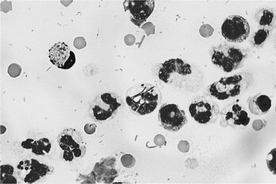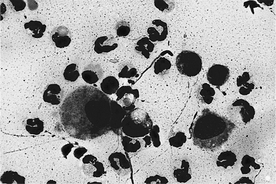41 CYTOLOGY OF INFLAMMATION
1 What is neutrophilic inflammation?
Preparations in which greater than 70% to 75% of the cells are neutrophils are referred to as having neutrophilic inflammation (Figure 41-1). Suppurative inflammation and purulent inflammation are other terms for a marked predominance of neutrophils (>85%). The terms “active” or “acute” inflammation are occasionally used for this type of cellular reaction, but in this case the terms relate only to the cell type and not to a time frame.
3 What is pyogranulomatous inflammation?
Preparations with an inflammatory population that contains both neutrophils and a prominent fraction of macrophages (15% to 50% macrophages) are referred to as showing pyogranulomatous inflammation (Figure 41-2). The term “chronic active inflammation” is sometimes used for this type of inflammatory reaction, although it is falling out of usage because it relates only to the cell reaction and should not be interpreted in relation to a time frame. Multinucleated giant cells, reactive fibroblasts, and lymphocytes may also be present in pyogranulomatous inflammation.
5 What is granulomatous (chronic) inflammation?
Preparations in which greater than 50% of the cells are macrophages are often referred to as having granulomatous inflammation. The term “chronic inflammation” is occasionally used, but this term relates only to the cell types present and does not indicate a time frame; thus it is falling out of usage. Multinucleated inflammatory giant cells, reactive fibroblasts, and lymphocytes may also be seen in granulomatous inflammation.
Stay updated, free articles. Join our Telegram channel

Full access? Get Clinical Tree




